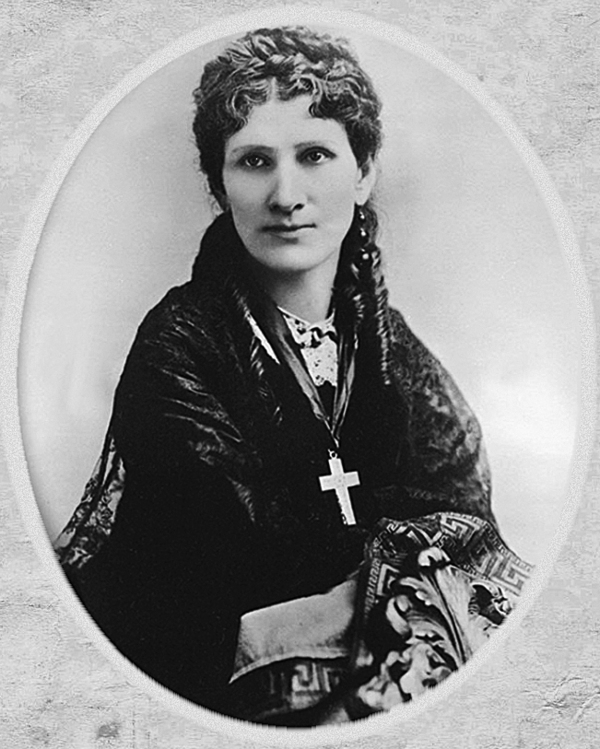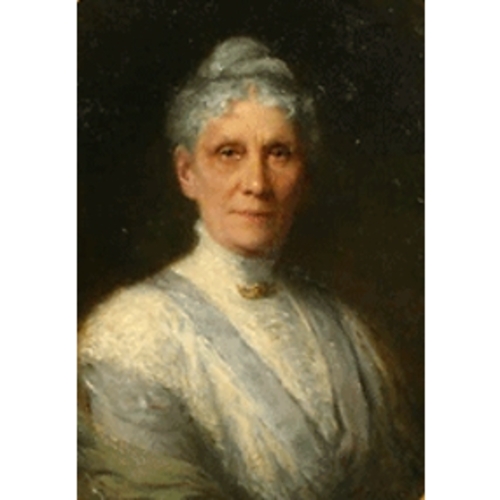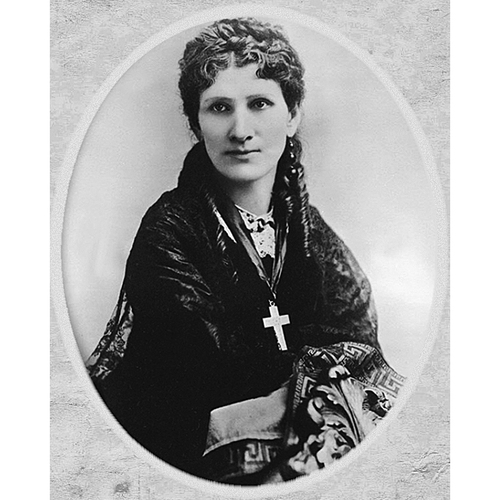
Source: Courtesy of Wikimedia Commons
EDWARDS, ANNA HARRIETTE (baptized Ann Harriet Emma) (Leonowens), author, educator, and feminist; b. 6 Nov. 1831 in Ahmadnagar, India, daughter of Sergeant Thomas Edwards of the Royal Sappers and Miners and Mary Anne Glasscock; m. 25 Dec. 1849 Thomas Leon Owens, a clerk, in Poona (Pune), India, and they had probably four children; d. 19 Jan. 1915 in Montreal.
Anna Harriette Leonowens always claimed that she had been born in Caernarvon, Wales, in 1834, the daughter of Captain Thomas Maxwell Crawford of an East India Company regiment; that she had gone out to Bombay in 1849; and that she had married a Major Leonowens of the commissariat in 1851. These assertions have since been conclusively disproved, and much of Leonowens’s remaining pre-1862 autobiography has been discarded as fabrication, woven to conceal her lower-class and possibly mixed racial origin.
Anna Leonowens was widowed in 1859, at which time her husband was the “Hotel Master” in Prince of Wales Island (Pinang, Malaysia). In order to support her family, she reputedly opened a school for officers’ children in Singapore, but she met with little financial success. In 1862 she was recommended to King Mongkut of Siam (Thailand) as a potential governess to the royal family, then composed of 67 offspring by the king’s numerous wives. Settling in Bangkok, Leonowens began a remarkable five-year career as “Mem Cha” (“M’am Dear”), which proved to be the pivotal event in a long and curious life. In 1868, while on leave for reasons of health, Leonowens resolved not to resume her posting. Then in the United States and badly in need of a livelihood, she opened a school for training kindergarten teachers in New Brighton (New York City).
Adept at self-promotion, Leonowens soon became known to James Thomas Fields, publisher of the prestigious Boston-based Atlantic Monthly. Under his sponsorship, a series of articles portraying her Siamese experiences appeared in that magazine during 1870, followed immediately by his publication of The English governess at the Siamese court. Since castigated as little more than plagiarism and fraudulent misrepresentation, the book was an immediate success. The themes of heroine versus villain, repression and brutality on the basis of gender, and life among the heathen in an exotic locale, not to mention a spirited condemnation of human bondage and servitude, appealed greatly to the Victorian sensibilities of post-bellum America.
The same themes were elaborated in The romance of the harem (Boston, 1873), which consolidated Leonowens’s popular appeal. Now a recognized author of some ability, she was in demand on the lucrative public-lecture circuit and had an entrée into advanced literary circles, where she claimed acquaintance with, among others, writers Oliver Wendell Holmes and Harriet Elizabeth Beecher Stowe.
In 1878 Leonowens’s daughter, Avis Annie Crawford Connybeare, married Thomas Fyshe, the cashier (general manager) of the Bank of Nova Scotia in Halifax. Having moved north with the newly-weds, Leonowens became an intrepid commuter along the Halifax–Boston–New York sea lane, ostensibly pursuing her literary and lecture-circuit activities. After Emperor Alexander II of Russia was assassinated on 13 March 1881, the Youth’s Companion, a popular Boston weekly, contracted Leonowens to cover the story. She reputedly reached St Petersburg within 13 days, and later claimed that she was the “first foreign woman author to travel through Russia with no protection and alone.” Her journey took her to Archangel (Arkhangel’sk), at least as far east as Kazan, and then to Odessa (Odesa, Ukraine). She returned home in September via Britain.
Before year’s end she had declined an offer to join the editorial staff of the Youth’s Companion, explaining that “I could not consent to live in Boston [when] my future great work of educating my grandchildren was already begun.” Their arrival was perhaps fortunate, since although Leonowens persevered in her literary career – books appeared in 1884 and 1889 – her popularity had waned, doubtless because she had exhausted her subject material.
Leonowens brought to her new mission the same vehemence she had used for dealing with King Mongkut. Daughter Avis, always a shadowy figure, was now completely superseded by “Grandmama,” who with her perfectionist son-in-law embarked upon “a most exceptional education” for the five grandchildren, emphasizing private schools, specialized music training, and incessant home study.
During these years Leonowens also made a valiant attempt to stimulate and contribute to the cultural life of Halifax. In the late 1870s she organized and served as librarian for the Pioneer Book Club; this informal purchasing and circulating library spawned an élite reading class which met weekly under Anna’s tutelage. In 1895 she continued this tradition with her Shakespeare Club for young women.
In 1887 Leonowens had become involved with the local art movement, which sought to establish, in conjunction with Queen Victoria’s golden jubilee, a formal institution in Halifax for non-academic art education and technical training. She supervised the successful Art Loan Exhibition, held to raise funds for the projected Victoria School of Art and Design, and she was appointed a director at the institution’s first annual meeting. She also went on the regional lecture circuit to attract funding and edited The art movement in America . . . (New York, 1887), a compilation of three articles she had reprinted for the school’s benefit.
Upon her return to Halifax in 1893 after a five-year educational sojourn in Germany with Avis and the grandchildren, Leonowens immediately resumed her involvement in the school, and she was instrumental in resolving a crisis brought about by financial overextension and inefficient administration. Although later she reportedly viewed herself as “the originator and . . . moving spirit” behind the school and saw its ultimate success as “very largely due to her determination, perseverance and enthusiasm,” Leonowens managed to concede that she had been “ably assisted” by others such as Mary Helena Kenny, merchant Michael Dwyer, and Chief Justice Sir William Young*. It is her involvement with the Victoria School for which she is best remembered in Halifax, and which has been commemorated in the Anna Leonowens Gallery of the present-day Nova Scotia College of Art and Design.
In August 1894 Leonowens’s focus of activity shifted as she appropriated a prominent role in the Halifax Local Council of Women, which had been inaugurated largely through the efforts of Edith Jessie Archibald*. Although she declined standing for executive office, Leonowens participated actively in various campaigns espoused by the council in its early years. These included enforcement of school truancy laws, development of a domestic science program within the school curriculum, improvement of city prison conditions for female offenders, and appointment of a matron to the waterfront immigration shed.
The coalition of interest groups represented in the council exemplified the attempt of Lady Aberdeen [Marjoribanks*] to promote nationally the welfare of women and children through collective action and marked a point of departure for the city’s early feminist movement. The concomitant preoccupation with enfranchisement was reflected locally in the founding of the Woman’s Suffrage Association in March 1895; Leonowens was president, assisted by Eliza Ritchie*, Mary Walcott Ritchie, and Charlotte McInnes.
Anna has been called the dean of Halifax feminists during this period, and in many ways she was indeed their most visible and articulate spokesperson, being a skilled advocate on the lecture platform and in newspaper columns. Moreover, her international literary reputation and carefully cultivated academic persona accorded her an authority other local feminists did not possess. Her aggressiveness and single-minded determination, however, militated against her. She was, in the end, perhaps too exotic for most Haligonians by whom she was remembered as “a regular Tartar” and, contrary to later stage and screen interpretations, “no glamour girl.”
In June 1897 the annual meeting of the National Council of Women of Canada was convened in Halifax, where the presence of Lady Aberdeen and American suffragist May Eliza Sewall highlighted the sub-theme of votes for women. Leonowens again attracted media attention, but the occasion was her swansong. Within days she had left the city, taking her eldest granddaughter for advanced piano training in Leipzig, Germany. The journey was broken in London by a memorable audience with King Chulalongkorn, Anna’s prize pupil from Bangkok.
The remainder of the Fyshe family also left Halifax in 1897, moving to Montreal, where Thomas had accepted a position with the Merchants’ Bank of Canada. It was there that Leonowens returned about 1901. The sudden death of Avis in 1902 left Anna as nominal head of the household, a role later accentuated by Thomas’s declining health. As usual, she tackled her responsibilities with vigour and determination, combining family management with community involvement. Increasing age, the departure of her grandchildren, and the diversity of the Montreal cultural community, however, together diminished Leonowens’s effectiveness. The death of Thomas Fyshe in 1911 removed from Anna’s life much of its remaining purpose; blinded by a stroke and confused by age, she lingered until 1915, when her death went largely unnoticed.
Leonowens’s reputation languished until 1944, when Margaret Dorothea Landon’s Anna and the king of Siam was published. This pastiche of Anna’s earlier books, with some biographical continuity, caught the public interest and led to the extravagant success of Richard Rodgers and Oscar Hammerstein’s Broadway musical and subsequent film, The king and I. Despite the continuing popularity of Anna’s years in Siam, her “real” life has been largely unexamined and, given the apparent dearth of personal papers, her long and colourful history will perhaps continue to be denied the serious analysis it so richly deserves.
[A fine portrait in oils of Anna Harriette Leonowens, executed by Robert Harris about 1905, was held by her great-grandson, Dr Thomas Fyshe of Hamilton, Ont. Following his death in 1998, his children Sarah Hvezda, Avis Boyar, and James Fyshe, donated it to the Confederation Centre Art Gallery in Charlottetown in the name of Thomas’s grandchildren.
Anna Leonowens’s two books on her Siamese experiences, The English governess at the Siamese court: being recollections of six years in the royal palace at Bangkok and The romance of the harem, were published at Boston in 1870 and December 1872 respectively (although the title page in the latter instance is dated 1873), and have gone through numerous subsequent impressions, editions, and reprints. “The English governess at the Siamese court” originally appeared in four instalments in the Atlantic Monthly (Boston), 25 (January–June 1870): 396–403, 554–65, 730–43; and 26 (July–December 1870): 144–55. The first three parts were published anonymously, but in the final instalment the author is identified as “Mrs Leonowent.” A facsimile of the original edition of The romance of the harem, edited and introduced by Susan Morgan, was published at Charlottesville, Va, and London in 1991.
Leonowens’s other publications include two further articles relating to Siam in the Atlantic Monthly: “The favorite of the harem” and “L’Ore, the slave of a Siamese queen,” 30 (July–December 1872): 335–45 and 462–70 respectively; “The favorite,” Youth’s Companion (Boston), 7 April 1881: 126; Life and travel in India: being recollections of a journey before the days of railroads (Philadelphia, 1884; repr. 1897); “Moscow ‘the holy,’” Halifax Critic, jubilee no., June 1887: 13–15; Our Asiatic cousins (Boston, 1889); and two items in the Halifax Herald: 25 Aug. 1894, and woman’s extra, 10 Aug. 1895.
The earliest biographical treatment of Anna Harriette Leonowens located to date is the anonymous, deliberately misleading, but nevertheless informative article “Her farewell to Halifax,” in the Halifax Herald, 19 June 1897. John Macnaughton, Mrs. Leonowens (Montreal, [1915?]), essentially repeats these basic details in a lengthy, hagiographic offprint from the University Magazine (Montreal), 14 (1915). M. [D. Mortenson] Landon, Anna and the king of Siam (New York, 1944), corroborates and expands upon the Halifax Herald material, using available personal and family papers. This book, an amalgam of Leonowens’s English governess and Romance of the harem, has gone through a number of reimpressions.
A. B. Griswold, King Mongkut of Siam (New York, 1961), was the first study to attack Leonowens’s credibility, the destruction of which was completed by W. S. Bristowe in Louis and the king of Siam (London, 1976); Bristowe had access to personal and family records from a source other than Landon’s. A possible attempt at retaliation was launched by Anna Harriet Leonowens Fyshe in “Anna and I,” Chatelaine (Toronto), 35 (1962), no.1: 32–33, 60–63, using basically the same material as that consulted by Landon.
Information on Leonowens’s Canadian activities is provided in P. R. Blakeley, “Anna of Siam in Canada,” Atlantic Advocate (Fredericton), 57 (1966–67), no.5: 41–45; it is supplemented by the Leonowens file in the Blakeley papers at PANS (MG 1, 3075, no.28), and by four articles in Edgar Andrew Collard’s column “Of many things . . .” in the Montreal Gazette, 6, 13, 20, and 27 Jan. 1979, especially “Anna lived in Montreal” (6 January) and “Why Anna came here” (20 January). Both authors were misinformed about Leonowens’s origins and early career.
Harold Pearse, “Anna as art advocate and educator,” Nova Scotia College of Art and Design, Art education div., NSCAD papers in art education ’88 (Halifax), 39–45, offers one of the few critical assessments to date of Leonowens’s non-literary career. Susan Morgan’s introduction in her 1991 edition of The romance of the harem provides a stimulating appraisal of Leonowens as a feminist author and discusses the issue of biographical integrity.
Leslie Smith Dow, Anna Leonowens: a life beyond “The king and I” (Lawrencetown Beach, N. S., 1991), presents an introductory biographical account for the non-specialist reader, but otherwise fails to advance Leonowens beyond Landon’s 1944 perspective.
E. R. Forbes, “Battles in another war: Edith Archibald and the Halifax feminist movement,” in his collection Challenging the regional stereotype: essays on the 20th century Maritimes (Fredericton, 1989), 67–89, is useful in establishing a contemporary background for Leonowens, as is Mary Helena Kenny’s scrapbook at PANS (MG 9, 10). The minute-books of the Halifax Local Council of Women (PANS, MG 20, 535, nos.1–2) are invaluable, as are the early records of the Victoria School of Art and Design, Halifax (PANS, MG 17, 6, 43–44). l.k.y.]
Cite This Article
Lois K. Yorke, “EDWARDS, ANNA HARRIETTE (baptized Ann Harriet Emma) (Leonowens),” in Dictionary of Canadian Biography, vol. 14, University of Toronto/Université Laval, 2003–, accessed November 21, 2024, https://www.biographi.ca/en/bio/edwards_anna_harriette_14E.html.
The citation above shows the format for footnotes and endnotes according to the Chicago manual of style (16th edition). Information to be used in other citation formats:
| Permalink: | https://www.biographi.ca/en/bio/edwards_anna_harriette_14E.html |
| Author of Article: | Lois K. Yorke |
| Title of Article: | EDWARDS, ANNA HARRIETTE (baptized Ann Harriet Emma) (Leonowens) |
| Publication Name: | Dictionary of Canadian Biography, vol. 14 |
| Publisher: | University of Toronto/Université Laval |
| Year of publication: | 1998 |
| Year of revision: | 2021 |
| Access Date: | November 21, 2024 |




